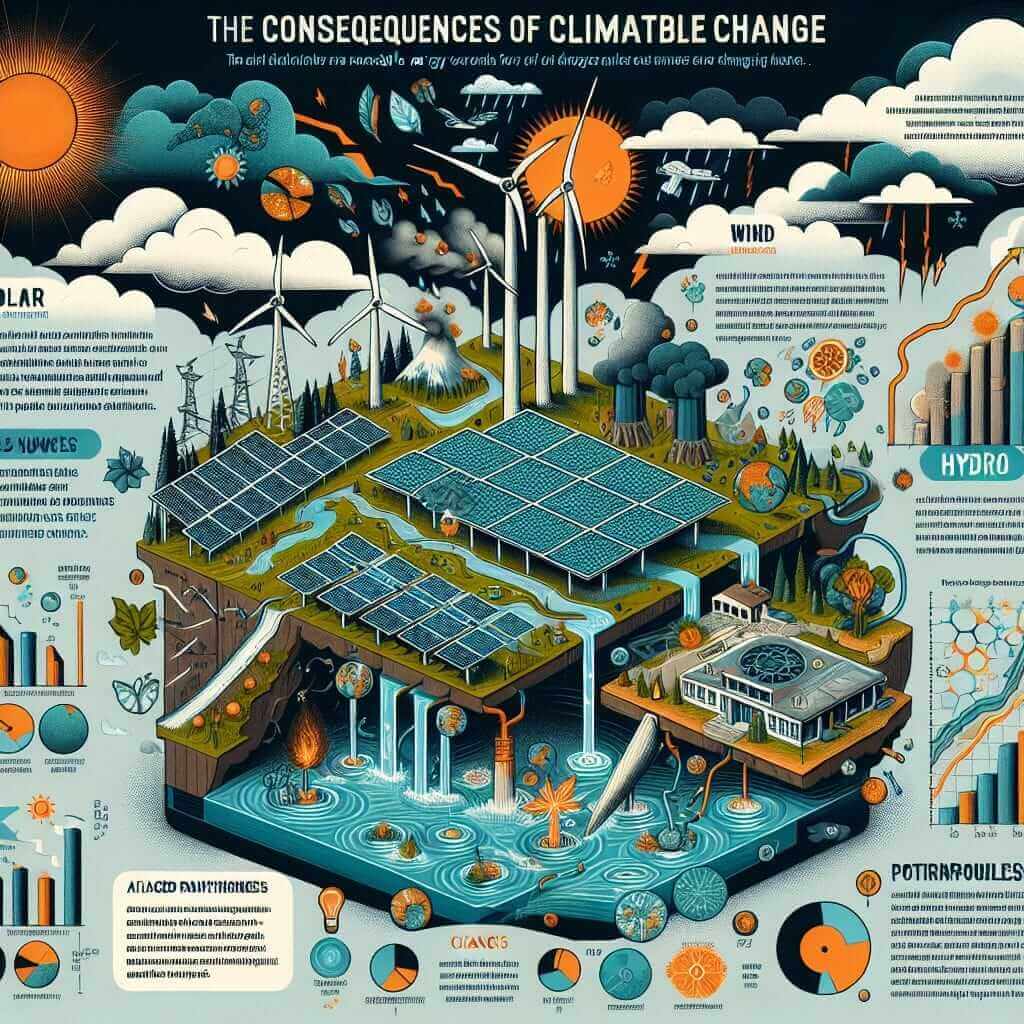The IELTS Reading test is a critical part of the IELTS exam that evaluates a candidate’s ability to comprehend texts and interpret the related information. Recently, many IELTS reading tests have featured topics related to climate change, given its pressing relevance in today’s world. One such topic, Effects of climate change on renewable energy sources, is not only significant but also presents a good chance of recurring in future tests due to its ongoing relevance and dynamic aspects.
Main Content
Reading Passage
Title: Effects of Climate Change on Renewable Energy Sources
The gradual escalation of Earth’s temperature has been triggering various environmental repercussions, one of which is its impact on renewable energy sources. As the globe endeavors to transition from fossil fuels to more sustainable energy, understanding how climatic changes affect these renewable options becomes paramount.
Solar energy, for instance, relies heavily on consistent sunlight. However, with climate change altering weather patterns, solar power generation faces challenges like increased cloud cover and more frequent storms. These changes can reduce solar panel efficiency, leading to inconsistent energy supply.
Wind energy, another crucial renewable source, is also subject to climate-induced changes. Wind patterns are significantly influenced by atmospheric conditions. As the climate warms, shifts in wind velocity and direction could occur, potentially making some regions less viable for wind farms. On the flip side, some areas might experience increased wind speeds, enhancing wind energy output.
Hydropower, heavily dependent on water flow, is particularly vulnerable to climate change. Changes in precipitation patterns can lead to either excessive rainfall or severe droughts. While increased rainfall might benefit hydropower production, prolonged droughts can drastically reduce water availability, leading to decreased electric generation.
Additionally, bioenergy, derived from organic materials, could see changes in the growth cycles of crops and forests due to shifting climate zones. Such fluctuations can impact biomass availability, affecting bioenergy efficiency and reliability.
In conclusion, while renewable energy sources are the cornerstone for a sustainable future, their efficacy is not wholly immune to the whims of climate change. Constant adaptation and innovations in technology are essential to mitigate these impacts and ensure a steady transition to green energy.
Question Section
1. Multiple Choice Questions
-
According to the passage, which renewable energy source is most affected by changes in cloud cover?
- a. Wind energy
- b. Solar energy
- c. Hydropower
- d. Bioenergy
-
What does the passage imply about wind energy’s future with climate change?
- a. Wind energy will become obsolete.
- b. All regions will become less viable for wind energy.
- c. Some regions may see improved wind conditions.
- d. Wind energy’s dependence on climate is insignificant.
2. Identifying Information (True/False/Not Given)
-
True/False/Not Given: The passage states that hydropower is unaffected by drought conditions.
-
True/False/Not Given: The passage suggests that climate change could enhance the efficiency of bioenergy everywhere.
3. Summary Completion
Complete the summary below using words from the box: (droughts, temperature, rainfall, viability)
Climate change impacts renewable energy sources differently. For instance, hydroelectric power is influenced by changes in ____, with either excessive ____ or severe ____ affecting energy production. Similarly, bioenergy depends on climate conditions, which can alter the ____ of biomass.
4. Matching Information
Match each statement to the correct renewable energy source (A, B, C, D).
A. Solar energy
B. Wind energy
C. Hydropower
D. Bioenergy
- This energy source depends on water flow.
- Crop and forest growth cycles impact this energy source.
- Changes in wind velocity can directly affect this source.
- This source relies on consistent sunlight.
Answer Keys
1. Multiple Choice Questions
- b. Solar energy
- c. Some regions may see improved wind conditions
2. Identifying Information (True/False/Not Given)
3. False
4. Not Given
3. Summary Completion
Climate change impacts renewable energy sources differently. For instance, hydroelectric power is influenced by changes in rainfall, with either excessive rainfall or severe droughts affecting energy production. Similarly, bioenergy depends on climate conditions, which can alter the viability of biomass.
4. Matching Information
5. C. Hydropower
6. D. Bioenergy
7. B. Wind energy
8. A. Solar energy
Error Analysis
Common mistakes in IELTS Reading:
- Misinterpreting the keywords: Always highlight or underline significant keywords in the text to avoid missing out on vital information.
- Overlooking specific details: Pay attention to qualifiers like “some,” “all,” “more,” “less” which drastically alter meanings.
- Matching headings: Be cautious as sometimes the first or last sentence of a paragraph holds the key.
Vocabulary
- Efficacy (noun): the ability to produce a desired result. /ɪˈfɪk.ə.si/
- Escalation (noun): a rapid increase; a rise. /ˌɛs.kəˈleɪ.ʃən/
- Mitigate (verb): to make less severe or serious. /ˈmɪt.ɪ.ɡeɪt/
- Viability (noun): ability to work successfully. /ˌvaɪəˈbɪl.ə.ti/
Grammar
Present Perfect Continuous: Used to show that something started in the past and has continued up into the present.
- Structure: [Subject] + [has/have been] + [verb+ing]
- Example: “The gradual escalation of Earth’s temperature has been triggering various environmental repercussions.”
Recommendations
- Practice Regularly: Engage with a variety of reading passages to become accustomed to different topics and question types.
- Keyword Identification: Practice identifying and understanding key ideas and concepts.
- Timed Practice: Simulate exam conditions by timing your practice sessions to improve speed and efficiency.

By dedicating time to understand passages like “Effects of climate change on renewable energy sources,” and applying the strategies outlined, improving your IELTS Reading score becomes a more attainable goal. Happy studying!